In April 1997 Life Magazine’s Director of Photography David Friend called out of the blue asking me to photograph comet Hale-Bopp, which at the time was streaking through the sky above sparsely populated Wyoming, where I had lived and worked as a staff photographer for the Casper Star-Tribune. Hale-Bopp was bright enough to be seen even during the day I recall. It was one of the most amazing astronomical shows of the 20th century, lasting 18-months. I wanted to get a uniquely-Wyoming photograph of it. Friend had seen and liked an image I shot of the comet high above Hell’s Half Acre earlier that month which I had uploaded to the A.P. wire. I asked him if he wanted the same kind of shot as before. No, he replied. He and his higher-ups had another idea in mind. For the magazine’s Big Picture spread, the section of standalone images that led off the magazine, they wanted a picture that conveyed the idea Bebop, a play on the word Hale-Bopp. Get it? He went on to explain. Get yourself a bar stool, find a saxophonist, and have him play some jazz riffs down in the bottom of Hell’s Half Acre as Hale-Bopp passes high above his head.
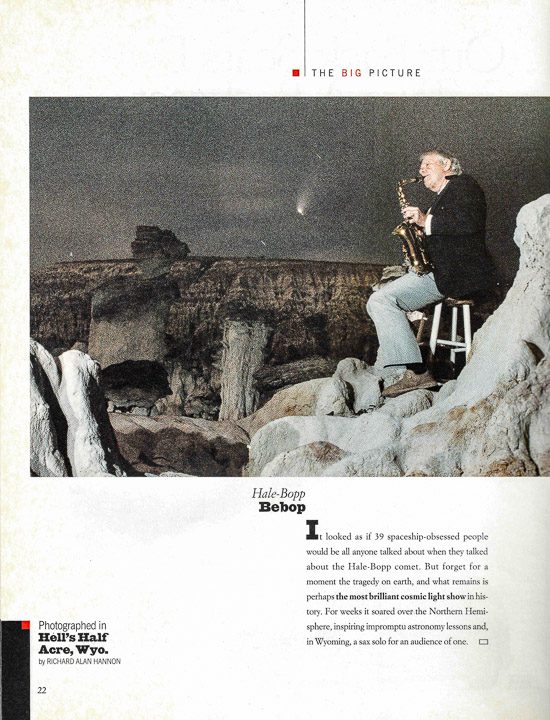
I was a young newspaper photographer then, brought up to think that a staged image like this was a cardinal sin. Friend was apologetic. He knew the contrived idea was, to say the least, short on journalism and long on utter weirdness. I agreed to shoot it even so. Life Magazine was calling. How cool is that!
I proceeded to buy a $27 bar stool, rented an alto saxophone for $10 a day, and through a mutual friend and colleague enlisted the help of Dick Frech, a local community theater actor. Frech couldn’t play the saxophone at all. Made it squeak as I recall. But he had an expressive personality. Plus, he was willing to drive with me 40 miles west of town in the middle of the night to fake the part of a seasoned bebop jazz saxophonist. And do it for free. He was perfect for the role.
Hell’s Half Acre was known by generations of local Native Americans as a buffalo jump, a place where tribe members on horseback funneled frightened, stampeding bison and ushered them right off the cliff. Kind of like the ending to Thelma & Louise, except the poor unsuspecting buffalo, who had no idea the cliff was coming. More recently, sci-fi fans may recognize the location as the backdrop for the 1997 movie Starship Troopers.
With my location scouted and my actor and props in place, I was all set. Over and over again I tripped the shutter button, letting it drag open for seconds on end as I ran around, stumbling and fumbling in the dark over jagged rocks and eroding soil, and popping off the small flash in my hand to ‘paint’ the ever-eroding landscape with light. These were the film days. Guessing long exposures and running around in the dark was quite challenging. Knowing the image was for Life, and that I had to get it right, making it even more stressful.
The image appeared in the June ’97 edition. An illustration of the sinking of the Titanic graces the cover along with an inset photo of Bill Clinton and his daughter Chelsea. I lost my copies of the magazine in a storage unit flood a few years back. I’d like to find a replacement copy someday.
Fast forward 23 years and another comet, NEOWISE (C/2020 F3) has come into view across the northern hemisphere. Not quite as magnificent as Hale-Bopp in size, luminance, or popularity, Neowise, named after NASA’s Near-Earth Object Wide-field Infrared Survey Explorer space-based telescope that ‘discovered’ it March 27, 2020, is impressive regardless. Since I’m living out West again, this time in Southwest Idaho, I had to photograph it.
This is easier said than done. Due to a booming population, light pollution in Southwest Idaho is growing at an exponential rate. Like Hale-Bopp, this comet shoots through the northwest sky. Growth is spreading in the same direction along I-84 to the Oregon state line. This has made it frustratingly hard to find a light pollution-free place to set up my tripod.
This past Friday evening my wife and I chose to head south, to a place along the Snake River called Celebration Park. The county park is home to truck-sized basalt boulders called melon gravel, many of which had fascinating and mysterious petroglyphs carved into them by hunter-gatherers thousands of years ago. The resulting comet photograph below is okay, but nothing to write home about. My shot of the Milky Way taken from the park but looking into the opposite sky was more interesting.
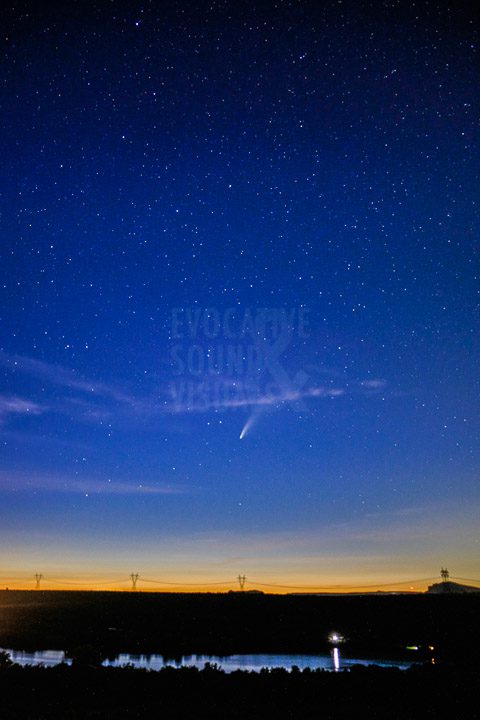
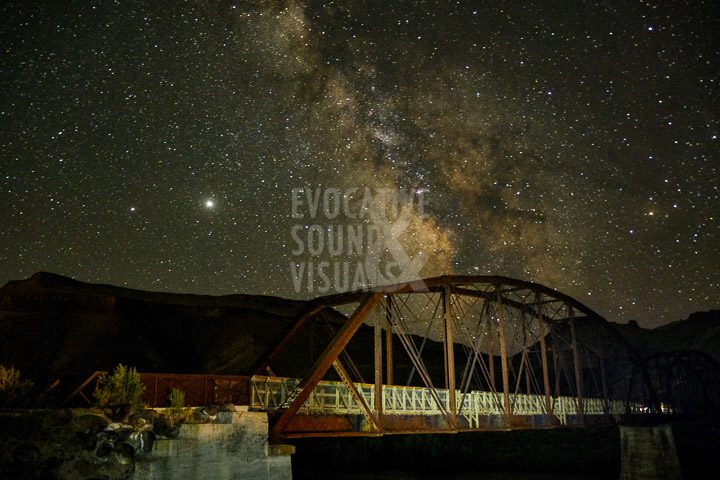
Last evening I chose to drive north of Boise’s city lights. To a pull off on the road to Emmett, Idaho that overlooks the west end of town. A handful of fellow photographers had the same idea I did and were there waiting patiently for the sun to go down. Covid-19 be damned. The images below are from this view. The International Space Station, shown as a streak in my long exposure, can be seen traveling ‘beneath’ Neowise and through the constellation Ursa Major, home of the Big Dipper. Capturing this shot was no accident. I used the web app Stellarium earlier in the afternoon to time the shot.
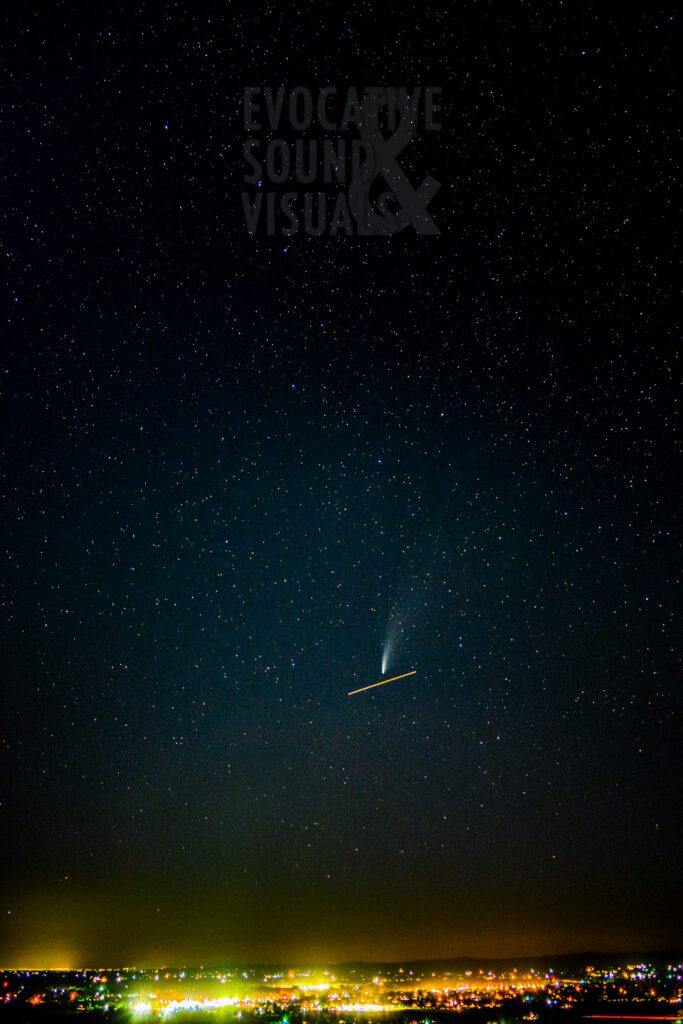
Below is how astronauts onboard the International Space Station saw comet Neowise as they passed above Turkmenistan on July 5, 2020.
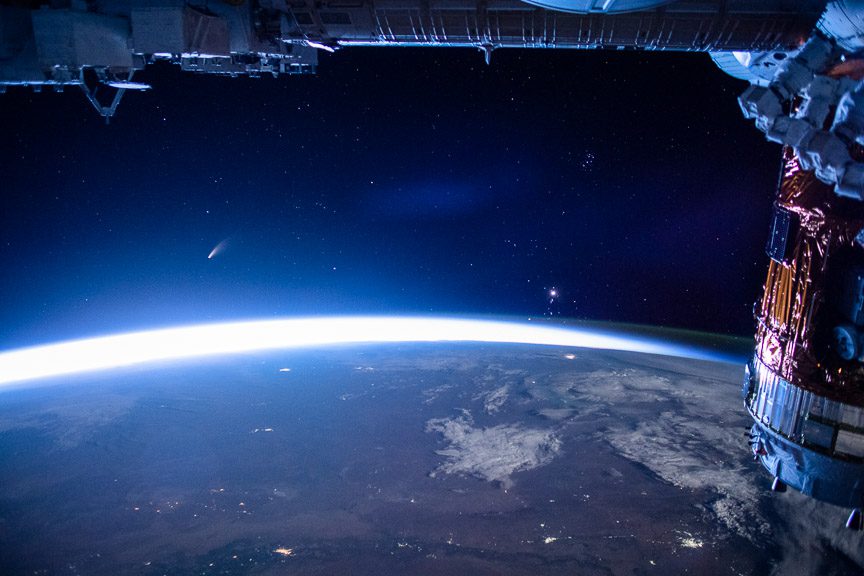
Life Magazine, as a monthly, left the newsstand 20 years ago. What I wouldn’t give to have photographed Hale-Bopp with the knowledge and equipment I have today. I’m still not satisfied with what I have of Neowise, although I’m at a loss to think of a better place to shoot it. Perhaps tonight, or very soon, I’ll make another go of it because it won’t be around for another 6,800 years.
Update July 26, 2020
I made another attempt at photographing Comet NEOWISE last evening, this time from the beautiful Dedication Point overlook in the Morley Nelson Snake River Birds of Prey National Conservation Area south of Melba, Idaho. Light pollution from the Boise metro area is visible, but not too bad. The comet is fading fast as it flies farther from the earth. At the same time, the moon is growing brighter. Yet I was able to pull off a few frames worth keeping.

And when I got bored with shooting the comet, all I had to do was turn around to see the Milky Way, Saturn and Jupiter in all their glory. The purplish light seen in the bottom left of the photograph below is cast by a scorpion hunter on the prowl. He had caught two by the time I left for the night.

Further Reading:
- My friend and former colleague Mike Seamans has been busy shooting new and interesting photos of comet NEOWISE in Maine almost every night it seems. I am amazed. Take a look at his fine work here.
- Comet Hale Bopp came with some tragic side effects. Read about them here at Space.com
- See my images of petroglyphs at Celebration Park here, and hear how the park sounds today.
- The late Dick Frech, my ‘saxophonist,’ has a scholarship named in his honor at Casper College, Learn more about it here and here.

